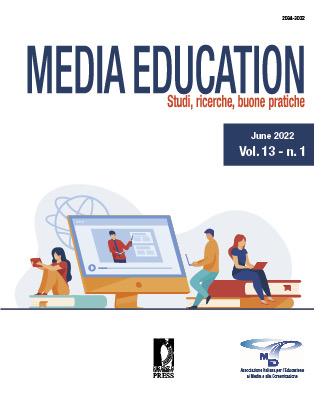Il ricorso al video nella formazione del docente della scuola dell’infanzia per la costruzione di competenze inclusive incarnate
Published 2022-04-29
Keywords
- Embodied Cognition Science,
- teacher training,
- school inclusion,
- embodied simulation,
- video
Abstract
Cognitive sciences and neuroscientific landings allow to support the existence of a circular dialogue between perception, action, emotion and cognition and their ability to influence and strengthen each other in the process of knowledge. These considerations are unavoidable, so they can and must have many impacts on teacher training. In particular, the training of support teachers requires cognitive reflections that are closely linked to experiential content, information, and body representations, that are capable of narrating effective and inclusive interpersonal relationships. After a description of the Embodied based constructs, that formed the basis of the training model, this contribution discusses about the treatment of the literature in support of the use of video both as an embodied training tool, designed to promote the centrality of the body in the processes of observation and simulation of inclusive strategies; and as a means of “narration” of effective and real inclusive processes, capable of having a positive impact on the perception of disability and its functioning. The undertaking of experiential and emotional body dimensions in training is an essential element, in order to promote, the construction of crossmodal skills of the teacher (corporeal-emotional-empathic) for the structuring of real inclusive processes and contexts in the classroom.
References
Dovigo, F., Pedone, F. (2019). I Bisogni Educativi Speciali. Una guida critica per insegnanti. Roma: Carocci.
Berthoz, A. (2004). Physiologie du changement de point de vue. In A. Berthoz, G. Jorland (eds.) L’Empathie (p. 251-275). Paris: Odile Jacob.
Bocci, F. (2014). La questione insegnante di sostegno, tra evoluzioni, boicottaggi e libertà di fare ricerca. Italian Journal of Special Education for Inclusion, II (2), pp. 139-153.
Caruana, F. & Borghi, A. (2016). Il cervello in azione. Bologna: il Mulino.
Damiano, E. (2013). La mediazione didattica. Milano: Franco Angeli.
Gallese, V. (2014). Bodily selves in relation: embodied simulation as second person perspective on intersubjectivity. Philosophical Transactions of the Royal Society of London B,369: 20130177. https://doi.org/10.1098/rstb.2013.0177, pp. 1-10.
Goldman, A. I. (2009). Mirroring, mindreading and simulation. In Jaime Pineda (ed.) Mirror Neuron Systems: The Role of Mirroring Processes In Social Cognition. New York: Humana Press.
Impedovo, M.A. (2018). Approccio riflessivo e alternanza pratica e teoria nella formazione degli insegnanti: un case study in Francia. Formazione & Insegnamento, 16(1), https://107346/-fei-XVI-01-18_22 pp. 279-287.
Gison, G., Vallefuoco, E. & Pepino, A. (2019) Piattaforma digitale per la progettazione degli interventi nel Disturbo dello Spettro Autistico SUPER (Sistema Unitario in una Piattaforma Educativa e Riabilitativa), IL TNPEE, VOL. 1, N. 1, maggio 2019, pp. 27-41.
Glenberg, A.M., (2008). Embodiment for education. In Calvo P. & Gomila A. (Eds.). Handbook of Cognitive Science: An Embodied Approach. San Diego: Elsevier.
Keysers, C. & Gazzola, V. (2009). Expanding the mirror: vicarious activity for actions, emotions, and sensations. Current Opinion in Neurobiology 2009, 19, https://10.1016/j.conb.2009.10.006, pp. 666–671.
Kersting, N. (2008). Using video clips of mathematics classroom instruction as item prompts to measure teachers’ knowledge of teaching mathematics. Educational and Psychological Measurement, 68(5), https://doi.org/10.1177/0013164407313369, pp. 845–861.
Koc, M. (2011). Let’s make a movie: investigating pre-service teachers’ reflections on using video-recorded roleplaying cases in Turkey. Teaching and Teacher Education, 27(1), https://doi.org/10.1016/j.tate.2010.07.006, pp. 95–106.
Korthagen, F., & Vasalos, A. (2005). Levels in reflection: Core reflection as a means to enhance professional development. Teachers and Teaching: Theory and Practice, 11(1), https://10.1080/1354060042000337093, pp. 47-71.
Marzano, A. (2019). Formazione per il cambiamento della scuola. Piani di miglioramento, azione e riflessione: un circolo teorico-pratico da ricomporre. In Calvani, A., Chiappetta Cajola, L. (a cura di) Strategie efficaci per la comprensione del testo. Il Reciprocal Teaching, (127-152) Firenze: S.Ap.I.E.
Murdaca, A.M. & Oliva, P. (2016). Valutare la percezione della disabilità, atteggiamento dell’insegnante, educazione inclusive, validità, affidabilità, analisi fattoriale (SACIE-R). In Perla L. (a cura di) La professionalità degli insegnanti, le ricerche e le pratiche, pp.127-128.
OMS (2001). Classificazione Internazionale del Funzionamento, della Disabilità e della salute (ICF). Trento: Erickson.
Oliva, P. & Murdaca, A. (2017). Competenza emotiva, strategie di coping e atteggiamenti inclusivi nella relazione insegnante/alunno ipovedente. Italian Journal of Special Education for Inclusion anno V, n. 2., pp. 43-51.
Poslawsky, I. E., Naber, F. B., Bakermans-Kranenburg, M.J., Van Daalen, E., Van Engeland, H. & Van IJzendoorn, M. H. (2014). Video-feedback Intervention to promote Positive Parenting adapted to Autism (VIPP-AUTI): A randomized controlled trial. Introduction Autism https://10.1177/1362361314537124, pp. 1-16.
Rivoltella, P.C. & Rossi, P.G. (2019). Il corpo e la macchina. Tecnologia, cultura, educazione. Brescia: Morcelliana.
Rizzolatti, G., Fadiga, L., Gallese, V. & Fogassi, L. (1996). Premotor cortex and the recognition of motor actions. Cognitive Brain Research, 3, https://10.1016/0926-6410(95)00038-0, pp. 131-141.
Rossi, P.G. (2016). Gli artefatti digitali e i processi di mediazione didattica. Pedagogia Oggi, 2, pp. 11-26.
Rossi, P.G. (2014). Prefazione. In Fedeli L. Embodiment e mondi virtuali. Implicazioni didattiche: Implicazioni didattiche. Milano: Franco Angeli.
Santagata, R., & Angelici, G. (2010). Studying the impact of the lesson analysis framework on preservice teachers’ abilities to reflect on videos of classroom teaching. Journal of Teacher Education, 61(4), https://doi.org/10.1177/0022487110369555, pp. 339–349.
Seidel, T., Blomberg, G., & Renkl, A. (2013). Instructional strategies for using video in teacher education. Teaching and Teacher Education, 34, https://doi.org/10.1016/j.tate.2013.03.004, pp. 56–65.
Schalock, R.L. & Verdugo Alonso, M.A. (2002). Handbook of Quality of Life for Human Service Practitionners. Whashington, DC.: Amer Assn on Intellectual & Devel.
Schön, D.A. (1999). Il professionista riflessivo: per una nuova epistemologia della pratica. Bari: Dedalo.
Sibilio, M. & Aiello, P. (2018). Lo sviluppo professionale dei docenti Ragionare di agentività per una scuola inclusiva. Napoli: Edises.
Wilson, R. & Foglia, L. (2013). Embodied Cognition. Wiley interdisciplinary reviews. Cognitive science, vol. 2, May 2013, https://10.1002/wcs.1226, pp. 1-7.


